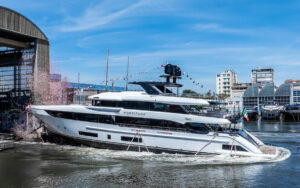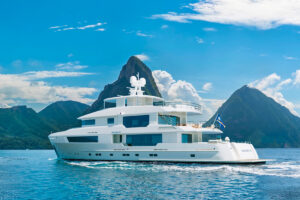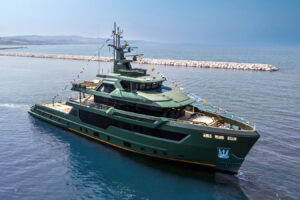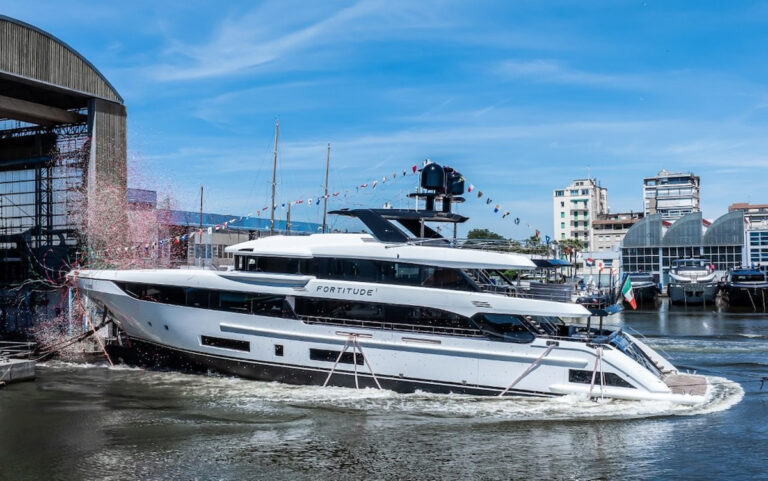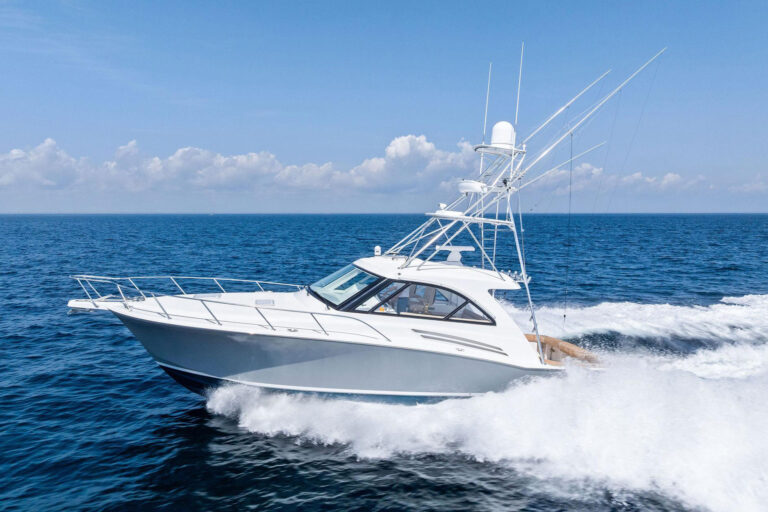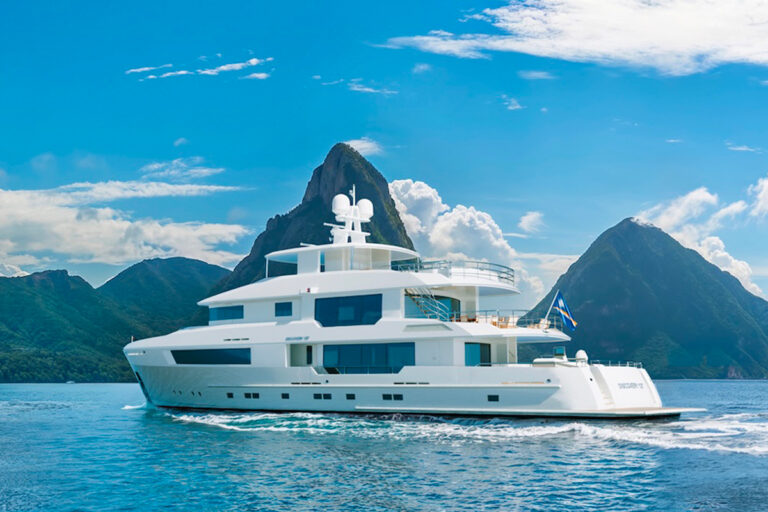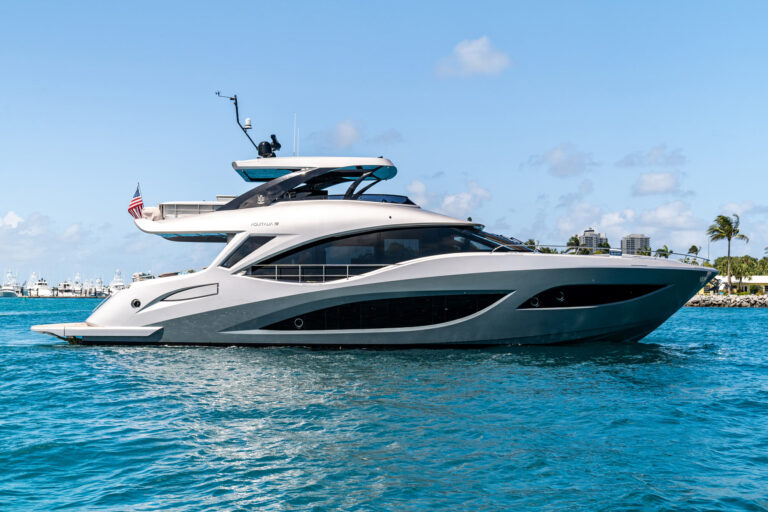Majestic. The word describes Mistral so well, you’d think both sprang from the same mind. L. Francis Herreshoff designed this 63′ schooner in 1937 and published her lines in his book “Sensible Cruising Designs.” I’ve drooled over those drawings for more than 20 years, wondering how she’d feel under my feet in a fresh breeze and feisty sea. I sensed she’d be a spirited and friendly boat, a partner for a lifetime.
She didn’t disappoint this past February, when a newly constructed, cold-molded version of Mistral appeared at the Strictly Sail Show in Miami and waited patiently for me in West Palm Beach. Big schooners love blustery weather, and that’s exactly what we got for our test sail.
We cast off a short time after midday and headed for the Lake Worth Inlet. The wind blew out of the east at 18 to 25 knots, chasing the seas before it. An ebbing tide sculpted a train of short 8′ to 10′ standing waves, which dumped solid water over our bow as we motored toward open sea. Of course Mistral pitched, but Herreshoff has distributed her volume so well that the motion wasn’t objectionable. I wouldn’t want to spend the whole day in this stuff-not on any boat-but Mistral made the best of it.
After we cleared the inlet, the seas lengthened but remained better than 6′ on average. We maintained our easterly course until we passed the turning buoy, then hoisted sail and bore off on a beam reach, headed north on starboard tack. Mistral was in her element.
This iteration of Mistral, per the owner’s request, sports a gaff-headed main instead of the Marconi rig Herreshoff drew for the original. The owner simply thinks the boat looks better with a gaff main and foresail. I agree. We could argue for hours about the performance trade-off between four-side and triangular sails. Most folks who haven’t sailed a gaff-rig boat say it won’t sail as close to the wind or be as fast to windward as a Marconi-rig boat. I challenge anyone to measure the advantage. Our measuring devices aren’t scaled for such small differences.
Be that as it may, gaff schooners live for screaming reaches, and we had one going. Oh my, she felt exactly as I imagined she would. She rose and fell majestically, splitting the crest of each wave, riding the broader body and shouldering aside any wave that dared slap her topsides. Rail down, spray shooting off the dolphin striker and the number 11 showing on the knotmeter, we rushed northward under foresail and jib.
This is when I made a big mistake.
My experience coaxed me to ask that we hoist the main to the first reef point, strike the foresail and leave the jib. I ignored my instincts because I’d never sailed this boat, and everyone aboard had even more experience than I. Under the combination of sail we flew, and Mistral exhibited serious weather helm. This isn’t normal. Almost any schooner will balance with only a touch of helm if you set the correct combination of sails. We had the center of effort way too far forward, so she behaved like a traditional Cape Cod catboat. In spite of Mistral‘s marvelous underbody and huge rudder, the sails definitely had the upper hand.
The shape of Mistral‘s water plane, the boat’s footprint in the water, is responsible for her comfortable motion in big seas, for her speed in light air and for her maximum speed. Her hollow entry transitions smoothly to maximum beam amidships, then runs aft in a graceful curve to close right forward of the rudder. This double-ended water plane also gives Mistral accurate and predictable steering at her maximum angle of heel. Her keel is long and shallow, which encourages her to track like a super-tanker when the sails are set properly. An autopilot could be redundant on this boat. Although her rudder is huge, Mistral won’t tack like a modern fin-keeler. She likes to sail through a tack, but you can nudge her around more quickly by backing the main. She won’t tack at all when you have only the foresail and head sails set.
Nathaniel Wilson Sailmakers made Mistral‘s suit of sails from North Sails Oceanus Dacron. They look and feel like canvas but have the same stretch and durability of conventional Dacron sails. Wilson says the material has just enough creep to set without a single wrinkle or stress line. Hall Spars made the masts, booms and gaffs from carbon fiber. Wilson said this was Hall’s first gaff rig, and it is beautifully designed and built. During my test, the sails set perfectly.
What a marvelous idea: a new old boat, and built of wood, no less. Legendary Yachts, bless its huge heart, appears to be on a crusade to keep alive the fine designs of Herreshoff and other artists from the first half of the 20th century. The boats are reproductions, not replicas, built to the original plans for the hull, deck and cabin trunk. The distinction between replica and reproduction is important to anyone who’s dreamed of having a classic boat but doesn’t want the headaches associated with maintaining an antique.
Stan Bishoprick, president of Legendary Yachts, told me one of the first questions prospective buyers ask is, “Why wood?” The short answer is, “Why not?” His longer one: “If you can keep water out of the bilge, you go a long way in eliminating the headaches of owning a wooden boat.” The craftsmen at Legendary planked Mistral with an inner layer of 11/4″ cedar followed by three courses of 1/4″ mahogany, all set in epoxy. Mahogany in its natural state strongly resists rot and abrasion. Saturated with epoxy, mahogany becomes wood-grain plastic, the fibers of which a builder can orient to line up with the loads on the structure. Floors, frames, backbone and stem are galvanized steel, painted with Awlgrip.
Combining a galvanized steel structure with a wood exterior produces a stronger hull than wood alone, but you get all the benefits of wood-a dry, warm, quiet, inviting environment. A 15 percent reduction in weight lets Legendary install all the modern amenities in a classic design without exceeding the original yacht’s designed displacement.
Legendary, with input from a naval architect, will modify the arrangement plans to suit the client’s requirements, to take advantage of modern systems components, or both. Mistral‘s layout has the auxiliary engine and other machinery back aft under the cockpit. (The original had the engine amidships.) Moving the tankage forward balances the weight distribution.
I love the accommodation. When I descended the companionway stairs, I thought the mahogany joinery may darken the cabins. After I settled in, she seemed perfect. Portlights and butterfly hatches let in more than enough light on sunny days. At night and on cloudy days, the many light fixtures make her glow with subdued warmth.
The owner’s stateroom forward of the saloon is big, but cozy. The double berth sits athwartships and is accessible from either side without forcing you to learn acrobatics. The stateroom has a desk designed especially for the owner’s manual typewriter, a large hanging locker and a dresser. The head, to port, forms the bulkhead into which Legendary built a full-height pantry, right opposite the galley. The presence of a dedicated wet locker just inside the companionway proves Mistral is a sensible cruising design.
Duplicating this version of Mistral would cost the buyer about $2 million, a steal considering the relative exclusivity she offers, the exceptional workmanship and her spirit. That’s correct: her spirit. This boat has a tremendous amount of character, a personality that could keep an owner hooked for a lifetime. No boat is perfect, but Mistral‘s combination of beauty, passagemaking ability and comfort are hard to beat.
Contact: Legendary Yachts Inc., Dept. Y, Box 206, Washougal, WA 98671. (360) 835-0342; fax (360) 835-5052; www.legendaryyachts.com.


